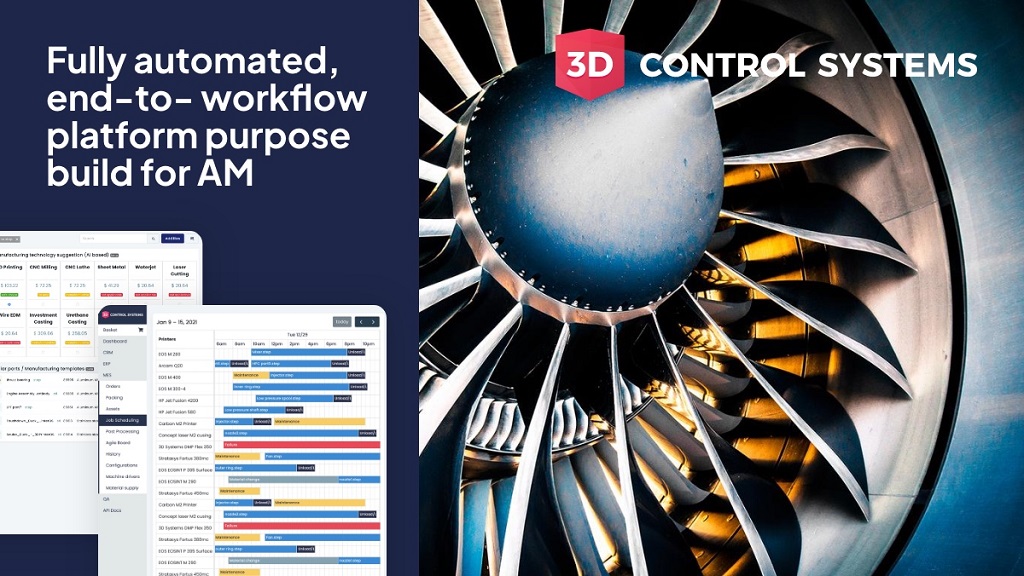
3D Control Systems formally announced their new ZAP system today.
If you haven’t heard of 3D Control Systems, don’t worry — they are the rebranded version of 3DPrinterOS, a very popular service that performs cloud-based management for fleets of 3D printers. That service is used by many organizations and is actually white-labeled with by several 3D printer manufacturers. You may have been using it and not even realized it.
3D Control Systems ZAP
3D Control Systems has parlayed their expertise in developing and managing cloud systems from that experience to create “ZAP”. They describe it as an “all-new advanced manufacturing platform”. And:
“The automated workflow platform integrates disparate 3D printer systems, frees users of risk for future technology integrations, and eliminates costs for system migration, deployment, and upgrades. This makes the new ZAP platform the ideal solution for advanced manufacturing factories that are looking to address requests that range from automating internal 3D printers to managing external production more efficiently.”
What exactly does that mean? ZAP contains functions for five main disciplines in manufacturing: CRM (Customer Relationship Management), PLM (Product Lifecycle Management), ERP (Enterprise Resource Planning), QA (Quality Assurance), and MES (Manufacturing Execution System).
Here’s a list of the vast functionality offered by ZAP:
- CRM: Customer Quote
- CRM: Management
- CRM: Customer Success Tracking
- CRM: Expense and Order Tracking
- CRM: Customer ROI Calculation
- ERP: Digital Part Inventory
- ERP: Manufacturing Process
- ERP: Suggestion (AI) Beta
- ERP: Manufacturing Templates (AI) Beta
- ERP: Use Case Screening
- ERP: Inventory Analysis
- ERP: Centralized Data Storage
- ERP: Printability Analysis
- ERP: Orientation Optimization
- ERP: Project Collaboration
- ERP: Version Control
- ERP: CAD Integrations
- ERP: Part Tagging
- PLM: Custom Part Requirements
- PLM: Automatic Order Management
- PLM: Material and Technology
- PLM: Comparison
- PLM: Accurate Part Pricing
- PLM: Custom Part Pricing
- PLM: Digital Communication Streams
- PLM: Distributed Manufacturing
- PLM: Networks
- PLM: 3D Printer Management
- PLM: CNC Mill Management
- PLM: Material Management
- PLM: Technology Management
- PLM: HR Management
- PLM: User Management
- MES: Custom AM Workflows
- MES: Smart Part Prioritization
- MES: Smart AM Farm Management
- MES: Post Processing Scheduling
- MES: Digital Production Planning
- MES: Part Sequence Tracking
- MES: Production Sheet Generation
- MES: Part Passport Generation
- MES: Quality Assurance
- MES: Machine Connectivity
- MES: Data Standardization
- QA: Scheduling
- QA: Process Management
- QA: Equipment Management
- QA: CT Scan to CAD Comparison (AI)
- QA: Machine Connectivity
That’s an incredibly comprehensive list of functions that any serious manufacturing operation could require, and ZAP bundles all of it in a single, integrated cloud service.
ZAP Future

While large manufacturers more than likely have systems to perform all these functions — and typically in a number of separate products — those products are sometimes not feasible for smaller manufacturers due to cost and complexity.
The ZAP offering could change that equation, as it may now be possible for smaller manufacturers to gain the benefits of this functionality at a lower cost and with far less complexity.
3D Control Systems’ cloud platform could also provide some interesting advantages as time passes. Cloud systems typically allow for consistently deployed system upgrades, whereas competitive standalone-installed products are far harder for software makers to manage. In other words, they can add functionality rapidly.
What might they add? It seems to me that their strategy is likely to add MES and other functions focusing on other types of equipment beyond 3D printing, which is their foundation. They’ve already included some of this in their current offering, but there’s plenty of room to add even more, and they have the ability to to so quickly.
The result will be a platform that could be attractive to more manufacturers, regardless of the type of equipment they operate. ZAP needs only to include the functions required, and it becomes a viable option.
This seems to be the ultimate conclusion for the original 3DPrinterOS concept launched so many years ago. It’s now become a true advanced manufacturing platform.
